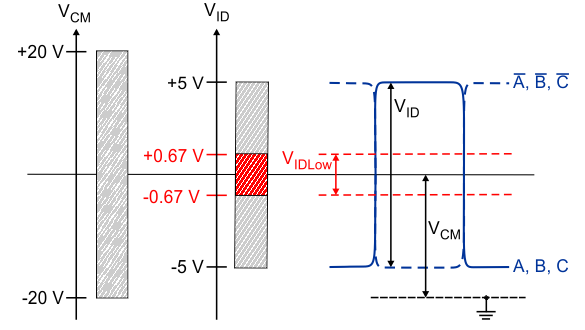Signal type RS422 (diff. input)
Differential signal levels according to RS422 are expected with the following settings in "Counter mode" (0x80n1:1D):
- 0: Encoder RS422 (diff. input)
- 1: Counter RS422 (diff. input)
A cut-off frequency of up to 20 million increments per second is permissible with 4-fold evaluation (corresponds to 5 MHz).
RS422 signal level |
| ||
| |||
| |||
| |||
| VCM | Common mode voltage range | |
| VID | Differential voltage | |
| VIDLow | Differential voltage too low | |
| A, B, C | Signals A, B, C | |
| A̅, B̅, C̅ | Inverted signals A̅, B̅, C̅ | |
Notice | |
Exceeding of Common Mode range Exceeding the Common Mode voltage range can lead to destruction of the device. |
RS422 - wire break and short circuit detection (open circuit)
In the RS422 (differential input) modes it is possible to detect a wire break or short circuit at the individual encoder inputs.
- In case of wire break, e.g. between input A and input A̅,
- the differential voltage VID is almost 0 V,
- which leads to an error with low differential voltage.
- In case of a short circuit, e.g. between input A and input A̅, the error behavior is similar to a wire break and also leads to error detection.
Activation and diagnosis of a wire break or short circuit can be found in the chapter RS422 - Wire break and short circuit detection (Open circuit).
 | Error bits not permanently set in case of wire break at an encoder input If a wire break is only present at one encoder input (e.g. only track A), it may happen in individual cases that the differential voltage (VID) is above the limit range (VIDLow) due to the applied common mode voltage (VCM). The corresponding error bits ("Open circuit" and "Error A") are not permanently present! |
Notice | |
Differential and single-ended connection The RS422 signal transmits a differential voltage, which makes the signal less sensitive to interference compared to a single-ended signal.
|
